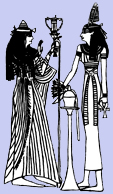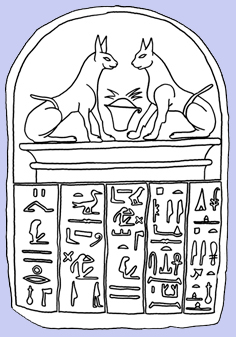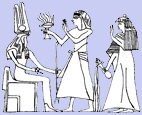Gender and Religious Practice in the Village of Deir el-Medina
This project focuses on the relatively well-documented village of Deir el-Medîna, home to the workmen and artists who built the royal tombs in the Valley of the Kings. Although this community was in some ways extraordinary because of its relative isolation and the special expertise of the people whom lived there, in other ways its material and social culture may be considered representative of contemporary practice elsewhere in Egypt.
Some aspects of religious activity in the village are very well-known and well-researched, such as the small monuments where people express a personal connection to a specific god (often in terms of asking pardon for offending the deity, praying for healing, or giving thanks for healing or forgiveness). Other aspects, such as the practical performance constraints of rituals, are much less well-known.

Women’s religious activities and aspirations at Deir el-Medîna have often been discussed in terms of fertility, childbirth and childrearing. These were certainly a major part of women’s lives, since it was essential to produce children who would grow up to look after their parents in old age. A very high child mortality rate forced women to bear a large number of children in the hope that some of them might survive to adulthood. However, the reduction of women’s religious lives to these spheres alone misses a great deal. Women also produced textiles, traded, cooked, kept house and were part of a social network, all of which might be drawn into connection with religion. Women played an active part in religious ceremonies in the village, notably as cultic singers, and during the week, when the men of the village were away at work, the women of the community may have been responsible for making offerings to the gods, at least within their homes.
On the other hand, very little work has been done on the connection between religious practice and the construction of masculinity in the village. For instance, their
male professional identity of belonging to the crew of royal necropolis craftsmen was expressed in the worship of Amenhotep I, patron of the crew, and of Ptah, patron of craftsmen, and in religious activities which took place at or in the vicinity of the worksite (processions in honour of Amenhotep I to the Valley of the Kings, religious activities in the shrine at the Valley of the Queens, and graffiti by the workmen, in honour of the gods amongst other purposes, all over the surrounding area.)
Religious and wisdom literature also offered men a variety of role models for human beings, such as the Horus type and Seth type from the Chester Beatty dream interpretation papyrus, and the silent man (to be emulated) and hot(-tempered) man (to be avoided). We can, to some extent, trace how positive identities were adopted and negative ones avoided in the personal piety literature. It is less clear whether such identities were also valid for women: There is little evidence on the topic.
Pictures, statues, objects and texts from the ancient world have often been used as evidence for how gender was constituted at different times and places. However, the sources themselves were in fact also part of the social processes which produced given forms of gender, and which influenced their contemporaries by giving them criteria to estimate behaviour and appearance for different sorts of women and men.

But gender does not exist in isolation. Gender is part of – maybe even not always the most important aspect of – a network of factors such as age, ethnic background, social status, character, talent and expertise. For instance, the religious experience of a married woman was probably somewhat different from that of her maiden daughter, not only because a married woman would have engaged with issues of fertility and birth differently from an unmarried one, but because the wife of the householder would have had more authority within the household than a young one.
Last year we collected a large quantity of published documentation about Deir el Medina, and will continue the process this year. Last summer we began to enter the published stelae into a database listing the worshippers and deities on each stela, their gestures and the objects they are holding, and the texts used to describe them.
Although women do not take first place on stelae where their husbands appear, they nonetheless are often represented holding libation vessels, birds for presentation to the gods, and (less often) braziers for burnt offerings. It seems likely that these cult objects denote active participation in the offering ritual.
Women’s presence is particularly marked in funerary stelae, where dead family members are represented receiving offerings from their descendants. Since these representations were thought to ensure that the dead would receive the supplies of food and drink which they needed to survive in the world to come, they tended to include as many people as possible.
Small children appeared surprisingly often on these stelae, usually in the company of their mothers when the whole family was involved in making offerings to their dead relatives.
Occasionally, however, the children accompanied their father or both parents in the more personal context of prayers to a god to intervene (to heal or pardon the donor of the stela, etc.) I am reminded of a letter sent by the scribe of Deir el-Medîna, Dhutmose, at the end of the Twentieth Dynasty, when he was away from home on a dangerous journey and asked his friends
and family to take the small children to the temple to plead for him to the god Amun to bring him back. Maybe it was felt that the prayers of small children would touch the god’s heart?
This year we plan to finish collecting the published artefacts from Deir el-Medîna, complete the stela database and compile similar databases of other relevant material, such as ostraca with drawings and scenes of worship and ritual in tombs from Deir el-Medîna, stressing the messages they convey about gender and possible contexts of use related to gender.
This coming spring I will give a lecture on the oracle ceremony at Deir el-Medîna, stressing gendered aspects of this ritual, at the conference of the Society for the Study of Ancient Law in Jerusalem. At Deir el-Medîna, the cult statue of the deified king Amenhotep I was often consulted as an oracle to identify culprits whose identity was unknown or against whom it was difficult to bring proof, and in certain other cases.
Another lecture, on the village of Deir el-Medîna and its surroundings as sacred landscape (again highlighting gender-related aspects), is planned for the department seminar during the summer term.
This research is supported by THE ISRAEL SCIENCE FOUNDATION (grant No. 815/05).



